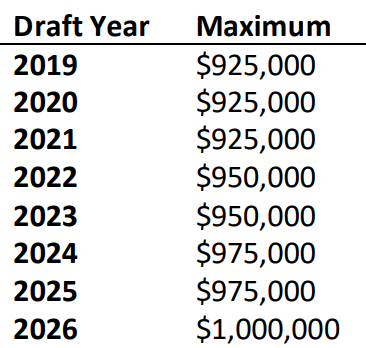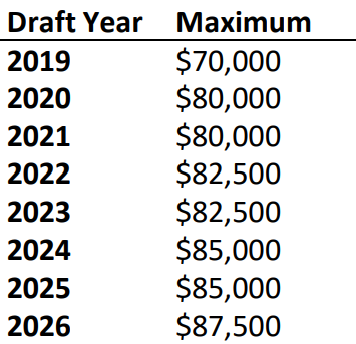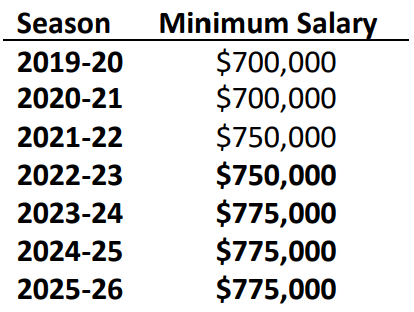NHL News
Key Salary Cap Changes in new CBA
The NHLPA and NHL voted to ratify the terms of the Memorandum of Understanding for a 4-year extension of the Collective Bargaining Agreement. You can find the full MOU HERE.
While many of the key terms have been widely reported, there are a few interesting changes that have not been as widely discussed.
Player Salary Deferral
From early on in the process, it was reported that the players will be deferring 10% of their 2020-2021 salary, and will be repaid for it in subsequent years. What about players who received their signing bonus on July 1, and have a small salary during the year? Take Connor McDavid for example, he received a $13M signing bonus already, and is set to have a salary of $1M during the season. If he deferred 10% of his $1M salary, that’s only $100K, or 0.7% of his compensation.
Under MOU 4, for players with insufficient salary to defer 10% of their 20-21 compensation, the NHLPA and NHL will agree on a mechanism to allow them to defer as much 20-21 salary as possible, including deferring all of their base salary if necessary. In the case of Connor McDavid, that would suggest he’s likely to defer all of his $1M base salary he’ll earn in 20-21. However, even with deferring all of that, he’d still only defer 7.1% of his 20-21 compensation. It does leave open the possibility of some additional way to make up the deferral, but as of now, it looks like players with very large signing bonuses may not be deferring the full 10%.
Another interesting nugget is this: “The parties also agree to continue discussions regarding the possibility of allowing Players and Clubs to negotiate additional deferrals on an individual basis within limits”. This suggests that teams and players may be able to negotiate additional deferrals, which would be a new wrinkle. Could we see the Bobby Bonilla of the NHL in the future?
Entry Level Compensation
The maximum Entry Level Compensation will increase (MOU 51) from the current $925,000 to the following:

The current maximum has been $925K for many years. It’s worth noting that the higher maximum isn’t based on the contract year, but rather based on the Draft Year. This means that the majority of entry level players actually receiving higher pay will not be until 2023-24 or 2024-25. As Entry Level signing bonuses are capped at 10% of the total compensation, this means the current maximum signing bonus of $92.5K will increase to $100K by 2026.
Minor League Compensation
The CBA limits the compensation in the minors for players on Entry Level Deals. Almost all Entry Level Deals include minor salary equal to the ELC minor league limit, which has been $70K for a number of years. This limit is increasing (MOU 52) as follows:

Players on NHL contracts can have minor league salaries that exceed the ELC minor league limit. However, the ELC minor league maximum tends to act as a floor for minor league salaries of non ELC players, so in a sense this serves as an increase to the minor league minimum.
NHL Minimum Salary
The NHL minimum Salary will be increasing per MOU 55. It was already set to increase to $750K in 21-22, and will now be as follows:

When a player’s contract no longer complies with the minimum NHL salary, it is automatically increased for that year and the Cap Hit/AAV increased. The most common example of this is when Entry Level Deals slide. Because they slide forward a year, often the base salary that the original contract called for is lower than the minimum salary in the new slide year. When that happens, the base salary increases to the new minimum for that year, and the Cap Hit increased.
The only player currently impacted by this is Mitch Marner, whose contract originally called for $750K salary in 2024-2025. This means it will now be increased to $775K, and his Cap Hit increased to $18,897,167
Minors Burying Threshold
The amount of Cap Relief that a team gets from assigning a player to the AHL is the lesser of their Cap Hit and the NHL Minimum Salary + $375,000 (Buried Threshold). Therefore, if a player with a Cap Hit less than the Buried Threshold is sent down, their full Cap Hit no longer counts on the Team's total cap hit. If a player has a Cap Hit greater than the Buried Threshold, when they are sent to AHL the team's Cap Hit is the player Cap Hit - Buried Threshold. With the new minimum salary, the new Buried Threshold is as follows:
2019-20: $700,000 + $375,000 = $1,075,000
2020-21: $700,000 + $375,000 = $1,075,000
2021-22: $750,000 + $375,000 = $1,125,000
2022-23: $750,000 + $375,000 = $1,125,000
2023-24: $775,000 + $375,000 = $1,150,000
2024-25: $775,000 + $375,000 = $1,150,000
2025-26: $775,000 + $375,000 = $1,150,000
8 Year Contracts for Players Re-Signing
The previous CBA allowed players signing with their existing team to sign contracts up to 8 years in length, and players signing with other teams a maximum term of 7 years. The cut-off was that a player had to be on a team’s roster at the most recent Trade Deadline in order to sign an extension that included an 8th year. The most prominent example was Erik Karlsson being traded from Ottawa to San Jose in Sept 2018, when his contract had one year remaining (expired July 1, 2019). He was eligible to sign an extension as of July 1, 2018, but since he was with Ottawa at the Feb 2019 trade deadline, he could only sign an 8-year extension with Ottawa until after the Feb 2020 trade deadline passed with him on San Jose’s roster.
In MOU 66, a player signed through the subsequent trade deadline who is eligible for an extension is immediately eligible to sign an 8-year extension with the new team. This means that Erik Karlsson would have been eligible to sign his 8-year deal with San Jose immediately.
Qualifying Offers
In the previous CBA, for a team to keep the rights to a Restricted Free Agent, they were required to make an offer of 100% of their final year base salary (if the player made $1M +). That led to some interesting contract structures, where the final year of the contract is much higher than the rest so that the RFA Qualifying Offer after the contract will be very high.
Take Timo Meier for Example, he signed a 4 year $6M Cap Hit, with a base salary of $10M in 2022-23, which is his final year before RFA status.

With this contract, San Jose must offer him a $10M salary in 2023 or he’ll become an Unrestricted Free Agent and they’ll lose his rights.
In the MOU 68, this changes. For contracts signed starting now, if the final year salary is more than 120% of the AAV/Cap Hit of the contract, then the Qualifying Offer required is only 120% of the AAV. In Meier’s example, instead of a $10M contract offer, this contract would require a $7.2M Qualifying to retain his RFA rights. This serves to lower the Qualifying Offer and therefore potentially lowering the next contract.
Entry-Level Performance “A” Bonuses for 19-20
MOU Attachment M discusses transition rules. An area that will impact players’ compensation as well as team potential bonus overages is how Entry Level Contract “A” performance bonuses will be calculated.
Some performance bonuses are based on a players’ ranking against his teammates (Top 6 Ice Time, Top 3 +/-, etc). To qualify for these bonuses, a minimum of 42 Games Played were required, and in addition, the comparison to teammates was based on teammates who played 42 games. This minimum has now been pro-rated to 36 Games Played. That means a player only needs 36 games to qualify for the bonuses based on these comparisons, and the comparison is against players who have played 36 games or more. Furthermore, if the player earns the bonus and is between 36-42 games, the bonus is pro-rated. If the player played 42 games and had already qualified, then they earn the full bonus.
Important to note, the statistics are not pro-rated, just the minimum games threshold. That means if a player scored 19 goals and was eligible for a bonus at 20 goals, they will not receive the bonus.
Performance Bonuses for Non-Entry Level Players for 19-20
Some players that are not on Entry Level Deals have performance bonuses in their contracts, such as previously injured players or those 35+. For determining their achievement of bonuses, if earning the bonus was based on:
-their team making the playoffs, that is only earned once the team enters the Round of 16 (either won the qualifying round or automatically makes Round of 16)
-their team winning playoff rounds, the Qualifying Round does not count. The first round won would be the Round of 16
-Games Played, the Qualifying Round Games Count as Games Played
For example, Mike Smith earns $125K if the Oilers make the playoffs. He would only earn that if the Oilers win their Qualifying Round. He also earns bonuses based on the Oilers winning playoff rounds; these would only start if the Oilers won their Round of 16 series.
Special Arbitration Wrinkle for 2020
For only the 2020 off-season, there’s a special arbitration wrinkle. Normally, if an RFA player and a team go to arbitration, and the team elects to walk away from the arbitration award, the player is a UFA and cannot sign with the team that walked away. Likely because of the expected cap crunch, there’s a chance for a “do-over”. Within 4 days of a team walking away from a player’s arbitration award, the team and player can agree to a contract that’s equal to the offer the team presented in the arbitration hearing. This might give a player a chance to rethink things if they ask for and win an arbitration award that the team cannot afford.
Team Bonus Carryover Overage: Calculating Final Team Cap Hit for 19-20 & Carryover Period
Teams are permitted to exceed the salary cap due to using Long-Term Injury Reserve and from Performance Bonuses that the player achieves. When teams have players that earn performance bonuses, those count against the final team cap hit. If the final team cap hit exceeds the salary cap, then there is a bonus overage that carries over to the following year.
Bonus Carryover Overage = Final Team Cap Hit + Performance Bonuses Earned - $81.5M Cap Ceiling
The big question was how would the final team cap hit be calculated considering the league paused on March 12? The answer is that 2 things will be assumed:
- The roster and team cap hit as of March 12 is assumed to be the roster and team cap hit through the last day of the regular season, with the exception of assumption 2
- Any players that were eligible for Loan (could be sent down to minors without waivers and were in AHL on "Clear Day") on March 13 will be assumed to have been sent down from March 13 through the last day of season
The first assumption was the easiest and most obvious method to handle this. The second assumption serves to lower the final team cap hit and potentially create less performance bonus carryover overages. Note that the current understanding is that only players assumed to be sent down are those that were in minors on “clear day” (trade deadline) and eligible for AHL playoffs.
In addition, typically the performance bonus carryover overage counts 100% against the next season cap. Special for overages caused by 19-20, teams will have the option to split the bonus overage 50% between 20-21 and 21-22.
Stay tuned for PuckPedia calculations of Final Team Cap Hits, expected Performance Bonuses Earned, and anticipated team performance bonus carryover overages.
What are your thoughts on these changes in the new CBA? Tell us in the Comments below!















